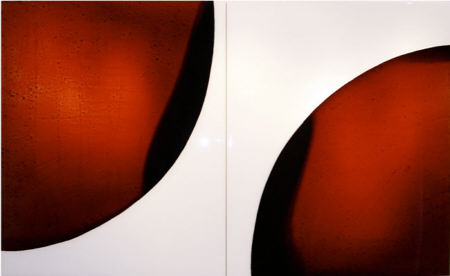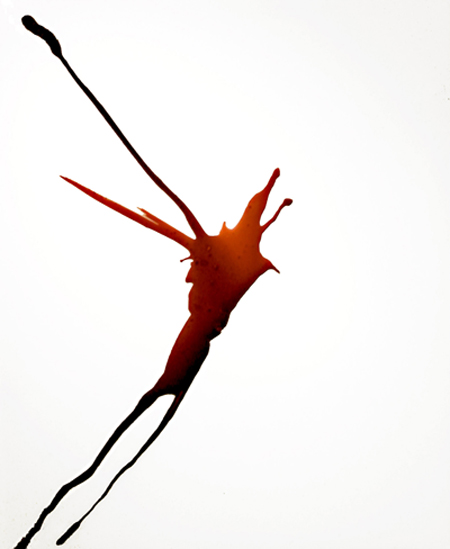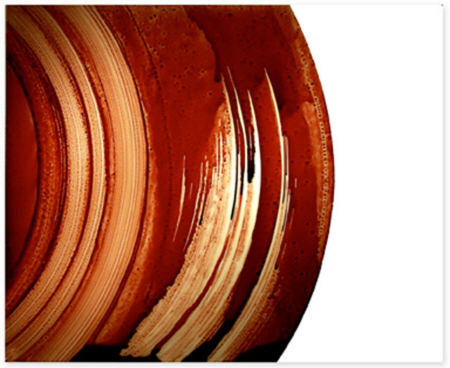I visited a couple of galleries in Chelsea during lunch and one of the galleries that I stopped by was the Merge Gallery where Jordan Eagles is exhibiting his ‘paintings’.

PHASE 1-2; 72″x44″; blood preserved on white Plexiglas, resin
As far as process goes, he uses cow blood trapped between sheets of UV resistant epoxy resin, lets the light play through the myriad textures formed out of the alternating layers of crusted blood of varied thickness and the result is pretty good. When you look at the work closely in person the alternating layers of deep red definitely lends the pieces a strange surreal beauty and looks mesmerizing – turn the lights down and the works start to glow refracting any available light through the layered epoxy resin. I enjoyed it in a surreal sense…
I filched the following from Jordan’s statement for this show.
In this series, I allow the forms and materiality to stand at the forefront, presenting an unbiased reflection of mortality, spirituality and infinity, while still offering the viewer space for a visceral and primal response. Some say they see in the work the astral origins of life while others see gunshot wounds. Regardless, the use of a flesh-based material to explore something as seemingly intangible as the spirit imparts a profound balance.

FK1; 36″x44″; blood, preserved on white Plexiglas, resin
I remember getting out of the gallery thinking the following:
Would this talented artist have gained a gallery show if he had used oil paints trapped in resin to develop the exact same shapes? My guess is no. I think he managed to elicit attention because he used blood – an attention seeker (like the chocolate in Jesus sculpture). This also reminded me of another artist Chris Ofili, who uses elephant shit and resin in his paintings (he won a Turner Prize in 1998)…
I guess the key to looking at art of this nature is to just imbibe the visual and extrasensory effects when you are in the presence of artworks like these. Of course, it again got me thinking along the classic lines of – Is this art or is this decoration? I am not so sure and I will leave it to you.
The art world today is an exciting and a fun place to be, provided you approach it with the right context.

ORB/FK; 44″x36″; blood preserved on white Plexiglas, resin
PS : I may be a little late in responding to this post as I will be at the hospital with my wife assisting in whatever way I can during the birth of our second child.

Thanks for sparing us the rest of the statement that really gets pretentious. :-) I have to say Eagles seems to have command of his materials, though he has apparently limited himself to a small number of forms. My favorite is the cosmic blast of EFK.
Sunil: Congatulations!
Some of us carry artifacts made from animal products in our medicine bags and some of us put it on our desks or hang it on our walls.
Appropriate for your day, Sunil. May it not be too bloody.
Congratulations.
Sunil, thank you for sharing this work with us. I personally find it fascinating. Yes, I believe the materials are important to the meaning of this work – if these were done in paint a lot would be lost. I don’t think it’s all about the final visual image. Process matters.
The artist’s statement is unfortunate. He’s kidding himself if he thinks his reflections of mortality, spirituality and infinity are “unbiased”. And it’s kind of off-putting to have him tell us about the “profound balance” his work imparts. I’d be more interested in hearing how he came to explore this medium and what it means to him.
Saw the show today thanks to this post, and told the sitter that I read about it right on this blog.
Totally neat stuff, and practically everything is sold. I like to think of it as art, rather than decoration, because Jordan’s statement never said anything about how it goes well with the furniture.
It was neat that the sitter and discussed how the galleries in the area get uber quiet in the summer because of the down time. One big reason is because everyone vacations for the summer. So really…someone who bought Jordan’s stuff might really be thinking that it goes well with red sofa by the fireplace…
(I’m switching from ‘jeff’ to my full name, woohoo!)
I think its interesting that you guys see Jordan’s statement as a bit of a failure. I think this is a perfect example of an artist who’s statement describes his very specific language–so specific that there is possibly a ‘wrong’ way to view his work.
I actually enjoy the statement mainly because I like viewing work where an artist is super specific about the interpretation of his/her work. I like being forced to see it through his/her eyes because it gets me out of my personal and normal perspective.
Jeffrey A. S.
Do you know whether, in earlier cultures, blood was used for painting symbols?
I’m not positive, but I would think that was a definite yes? If I lived in a time before the wheel, I’d definitely be using any source–including all my bodily fluids–for mark making.
I didn’t see the ‘astral origins of life’ in these paintings, but I could definitely feel something more than if it were painted with normal paint–which is interesting if you think about it because ‘normal paint’ was originally organic materials. I think blood just has that powerful connotation.
One of my favorite movies of all time, Kill Bill 1, has an awesome fight scene with tons of blood. The director, Quentin Tarantino, said that the scene had to be edited into black and white to avoid a movie rating of NC-17. Even today, that ‘Blood Red’ color has got some crazy power…
I was awed by the beauty of red blood cells flowing through intact, transparent, glistening, tiny capillaries when I dissected out the CNS of leeches in earlier times.
I don’t see this awesome beauty of life in the pictures shown here. Instead, I feel the violence of shed blood and I have my visceral response to it.
That is why I asked about the usage of blood in earlier cultures. I was thinking of the aztecs.
Its cool that we both went down the ‘blood=violence’ path–as opposed to something else like…religious connotations. Though, I am curious to know if these paintings made anyone go down a different ‘blood’ path.
Sunil,
Thanks for the introduction to Jordan Eagles. Like everyone else, I rather wish he had written a “merely competent” artist statement.
I like the images, insofar as I can make them out on a web page or two; I think the material is extremely important and that you couldn’t get the same effect with acrylic, even if you tried.
But as a somewhat squeamish person, I was thinking of the smell and metallic taste of blood, and then found myself thinking about mammograms, which squish something living between two pieces of plastic (or at least I think it’s plastic — I’m too squeamish to look).
It’s possible that someone could do a visual scree on mammograms and use the same artist statement — all that stuff about a fixed moment of spirituality, etc. In fact, most of the stuff in the art. statement might fit a living tissue rather than the blood of a presumably dead cow much better.
I didn’t think either religion or violence in conjunction with the images, although I did think “icky,” imagining myself dealing with a basin of cow’s blood. One of them did seem more violent than the others, but in conjunction with the others, the impact was more intellectual and color oriented for me. Mostly I marveled at the patterns and wished I could see them in real reality and assess for myself the ways the light hits the blood and so forth.
Sunil, you did a fine job of describing them, good enough to make me want to take the train east.
I imagine an elegant room, on juxtaposed walls
War in Irak on Lcd monitor and cow blood in resin.
A message from the bio front: it may have been already mentioned, but Damien Hirst has traded out his old shark for new. It is reported that the replacement is not quite a dead ringer for the old, but it looks nice and fresh and its preservation is up to date.
I’ll play the age card with a good old “back in the day” comment. In the late sixties blood meant something. I can remember one poor soul who made a public demonstration of cutting his penis with a razor blade. In 1971 Chris Burden had a friend shoot him in the arm with a pistol. This and the medical aftermath constituted the artistic event.
There blood was used as evidence of risk and danger. Blood was also employed as a medium of protest as when a group of clergy broke into a selective service office and poured cow’s blood over draft records to protest the Vietnam War. More recently Gilbert and George have created powerful work employing images of droplets and blood-red ink in an AIDs context. One can imagine a lot of Pollock’s blood, sweat and tears intertwined in his paint.
Jordan Eagles’s work looks nice enough but it seems to me that the announced use of blood should infer more. For some reason the glowing effect reminds me of a sushi palace. I was trimming a piece of spruce yesterday and found the rich glow of light passing through the papery cutoff to be fascinating as well.
Congratulations Sunil! Children are a blessing. Perhaps you can find a nice image of a cigar to share with us.
Jay,
You’re right about Eagle’s prettifying of a material that has been used in far more intense ways.
Chris Burden was featured in a recent New Yorker article by Peter Schjeldahl (May 14). Burden’s final stunt (after having himself nailed to a Volkswagon and otherwise “incurred apparent risks of burning, drowning, and electrocution” was to lie under a sheet of glass for 45 hours, ten minutes. A museum attendant finally couldn’t stand it and placed a glass of water within his reach. Burden (presumably) drank the water, broke the glass, and renounced the game of self-destruction.
Schjeldahl remarks on the irony of the attendant’s action, in which the person who is supposed to guard the art finds it necessary to destroy it, presumably in the name of a greater humanity. Schjeldahl also remarks on how this kind of deathwatch absolved the museum visitors of responsibility because it blocked them from “desecrating” the art. It was, Schjeldahl announces, a silly game, in which the ultimate limits were found in this self-destructive action. Burden now makes track-racing toy cars, among other bits of art activities.
“The history of the avant-garde comes down to this,” says Schjeldahl, “a boyish gimcracker diverting us by diverting himself. Worse things have happened.”
Schjeldahl’s definition of art in the article also caught me: “In pragmatic terms, art is a privileged zone of gratuitous activity, with boundaries maintained by the agreement of the vested authorities.” Artist tried to effaced the boundaries which kept being redrawn — until Burden went as far as a (live) artist could go.
June:
Long time, no chat.
I’ll certainly agree with the gentleman’s use of “gratuitous” if understood in its first definition: “given unearned or without recompense”.
If the word is construed as “not called for by the circumstances” then we might have given any number of activities the heave ho. Some of my favorite design mags are full of beautifully crafted utensils whose strong aesthetics I see as artistic. The practice of designing and making these things is not gratuitous unless one opts for some kind of requisite pug ugly.
Concerning Burden – who can be one -: perhaps the point was to force a resolution to a dilemma. Burden held his breath, as it were, until somebody demonstrated a lovely concern for his welfare and brought the sad episode to a fitting conclusion. Instead of desecration, maybe that was the art.
Anyway, there’s some showman named Blaine (?) who does it better and without the arty baggage.
Steve and Birgit,
Thanks for your best wishes. All is fine on the family front.
For some reason, even though I found the statement a bit vaporous, the show itself had a lot to offer and I actually enjoyed the same.
David,
I agree whole heartedly with you when you say “I’d be more interested in hearing how he came to explore this medium and what it means to him” and you are also very correct that process also matters a lot sometimes (even if it is with cow blood).
Jeff,
Yes, most of the stuff was sold out – definitely a good sign for Jordan. Although I still think that the statement was slightly skewed to suit the work – I can’t think that blood trapped in resin imparts any sort f life force when actually the image of blood as a living spurting thing is all I can conjure… Cow blood does have a religious connotation in the Hindu religion – now that you bought it up… (I did not mind it though)
June,
A competent, down to earth artist statement would have helped me too, but I did enjoy the works a lot.
Jay,
Isn’t what you are saying hinge on performance art – whereas Jordan’s work seem like art meant to be hung on walls… for some reason the two are different for me – I remember Burden – that was spooky.
You are right about Blaine – showman without the art – I wonder: Can magicians call themselves performance artists in the same way the art world defines the word performance art?? Interesting angle there….
Thank you for your best wishes.
I find this work incredibly boring and bland, therefore I’m not surprised it sold so well.
Compare this to the work of Andres Serrano, for example, and you can see where this artist is lacking.
The religious comparison is interesting insofar as one could go to a church and find a glass reliquary with dried blood in it but these works seem so expressionless that it’s difficult for me to compare them to much of anything. I’m sure they will look great above someone’s sofa, though.
SuniL:
Somewhere at my bedside is a very elementary primer on Hinduism. Your comment about the cow’s blood seemed to point, perhaps, to your own background.
I know that I would be edified to know how Hindu customs and/or beliefs intersect with an Indian’s artistic practices. I might remember a visit by your family to a gallery and the spirited discussion that followed.
Don’t mean to pry, but the sheer depth and complexity of Indian culture and beliefs arouses my curiosity.
Tree,
Andres Serrano is a genius. This guy is just starting out. I think he has quite some potential.. Yes, it will look good above a sofa. No doubts.
Jay,
It is amazing that you read into the cow’s blood part of the post. Yes, even if this was not mentioned as part of the gallery statement, I wanted to find out what kind of blood the artist used. Cow’s blood it was. Being a Hindu, I guess I should have reacted in some sanctimonious manner, but I guess I am beyond that. That said, I do no think that I can buy a small piece of this artists work and bring it home as I know that my ageing parents (who happen to be staying with us at this moment) would be offended. The cow as you have alluded is sacred in the Hindu tradition and I think it would go against my parents sensibilities if I were to do that. As I did not have any beef with his work, I did talk about the work at home and all I got was non-compliant stares.
As I did not have any beef with his work…
Sunil, I hope that’s deliberate play on words, because it’s hilarious!
David:
That’s a lot of bull.
Sunil:
That clears some things up. One thing the book points out is the special geographical connection between Hinduism and the Indian subcontinent. Many would assert that one cannot be Hindu and live elsewhere. I remain curious about this, but perhaps should back off.
That’s a lot of bull.
Oh no, look what I started :)
David,
Yes, that was delibrate – wanted to have a little fun there…
Jay,
Even as recently as 150 years ago Hindus crossing the seas and going abroad would have to go through a purification ceremony on returning back to India (commonly referred to as a ‘Prayaschitta’ or atonement ceremony) and only then could they be integrated into regular life… The taboo against crossing the seas has been cited as a possible reason for the popular claim that India has never attacked other states but has been invaded multiple times… Of course I am out of my league here and I should really be referring you to some history books…